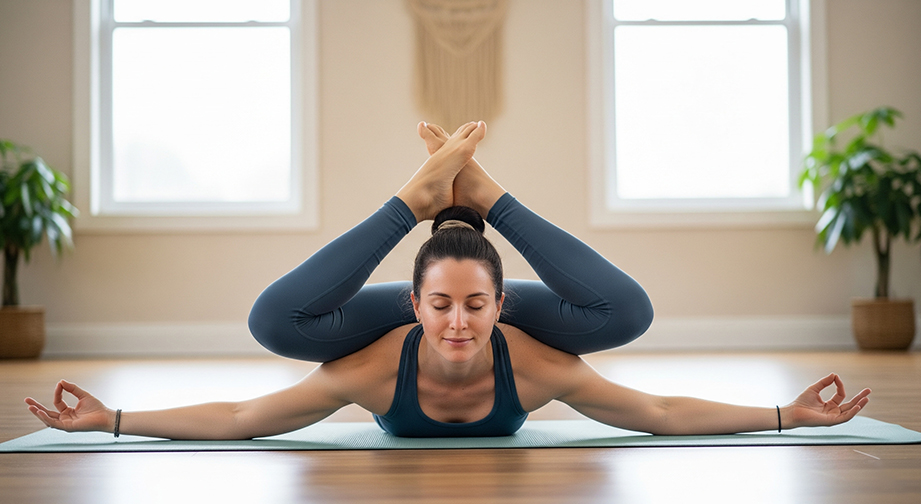Yoganidrasana (Yogic Sleep Noose Pose / Pasini Mudra): How-To Guide, Benefits & Safety
Introduction
Yoganidrasana—also called the Yogic Sleep Pose or Pasini Mudra—is a unique reclining yoga posture where your legs are wrapped behind your head as you lie flat on your back. Don't worry—it looks intense, but with patience and modifications, it’s accessible to many levels!
In Sanskrit, "Yoganidrasana" means "yogic sleep pose," while "Pasini Mudra" refers to the "noose gesture." The soul of this pose? Deep release and serenity.
If you've ever felt stiff and mentally overloaded after a long workday, Yoganidrasana can feel like pressing the reset button—both for your body and your mind!
Step-by-Step Guide to Yoganidrasana (Yogic Sleep Noose Pose)

- Warm-up First: Open your hips and hamstrings with a few rounds of Downward Dog, Happy Baby, and Reclined Pigeon Pose.
- Start on Your Back: Lie flat with your knees bent. Keep your feet on the mat and arms relaxed.
- Lift Your Legs: Bring both knees toward your chest, keeping your lower back grounded. Take a deep inhale.
- Position Your Legs: Open your knees wider than your torso. Exhale and gently try to wrap your legs around your upper arms, bringing knees towards your armpits. Hold here; keep breathing steadily.
- Thread Your Legs Behind Your Head: Using your hands, carefully guide each leg behind your shoulders (or as close as your body comfortably allows).
On an exhale, ease your feet so they meet or cross behind your head—never forcing.
- Clasp Hands (if Accessible): For the fullest expression, reach your arms forward and clasp hands in front of your shins, as if hugging yourself.
- Hold & Breathe: Take slow, deep breaths. Inhale through your nose, exhale out slowly, feeling your whole body relax.
Duration: Stay here for 5–10 breaths, or up to 1 minute. Repeat once or twice if comfortable.
Modifications for Beginners:
- Use a strap or hold behind your thighs to assist.
- Place a folded blanket under your neck or head for comfort and protection.
- Simply hug knees toward the chest and rest—no need to go all the way!
Intensifications for Advanced Yogis:
- Try clasping hands past your legs (further forward) or deepen the shoulder wrap.
- Work toward straightening the legs behind the head, only if flexibility allows and no pain is felt.
Alignment & Safety Tips
- Key Alignment: Keep your neck long and shoulders away from the ears.
- Common Mistake: Rounding the lower back and straining the neck—avoid by working gradually into the pose, not forcing the legs.
- Safety Precautions:
- If you feel pinching or sharp discomfort, back off immediately.
- Do not attempt if you have spine, neck, hamstring, or hip injuries.
- Not recommended for pregnant practitioners or those with herniated discs.
Benefits of Yoganidrasana
Physical Benefits
- Deeply stretches hips, hamstrings, and spine
- Improves flexibility—especially in the lower body
- Enhances posture by decompressing the vertebrae
- Helps relieve tension in back and legs
Mental Benefits
- Encourages total relaxation—often likened to yogic sleep
- Reduces anxiety and promotes a calm mind
- Supports mindfulness by drawing attention inward
Energy & Chakra Connection
- Opens the Muladhara (Root) and Svadhisthana (Sacral) chakras
- Promotes a sense of grounding and energetic release
Contraindications
- Pregnancy or recent abdominal surgery
- Severe neck, back, hip, or hamstring injuries
- Chronic sciatica or herniated discs
- Painful arthritis in hips or knees
Alternatives:
- Happy Baby Pose (Ananda Balasana): Gentle hip opener without strain
- Reclined Pigeon (Supta Kapotasana): Stretches hips safely
Beginner’s Tips & Variations
- Props: Use a yoga strap to hold your legs or a bolster under knees for gentler stretch.
- Gentle Variation: Hug one knee toward your armpit, resting opposite foot on the floor.
- Advanced Variation: Once in full pose, slowly attempt to straighten legs further, or clasp elbows in front of shins for a deeper bind.
How To Include Yoganidrasana In Your Yoga Flow
- Best as a cool-down or main deep stretch after warming up thoroughly.
- Pairs well with:
- Happy Baby Pose (Ananda Balasana)
- Reclined Pigeon (Supta Kapotasana)
- Seated Forward Fold (Paschimottanasana)
Mind-Body Connection
Yoganidrasana is almost meditative—focus on relaxing your body and watching your breath. Let thoughts drift by as you sink into the pose. This asana is tied to root and sacral chakra balancing, freeing up “stuck” energy and bringing deep calm.
Asana Name: Yoganidrasana (Yogic Sleep Noose Pose / Pasini Mudra)
Level: Advanced (modifications suitable for intermediates)
Focus Areas: Hips, hamstrings, spine, shoulders
Duration: 5–10 deep breaths (up to 1 minute)
Best Time to Practice: Morning or Evening, after warming up
FAQs about Yoganidrasana (Yogic Sleep Pose)
Is Yoganidrasana suitable for beginners?
It’s considered an advanced posture, but with props and gentle variations, beginners can work safely toward it.
What if I can't get my legs behind my head?
No problem! Simply holding your knees toward your chest or working in Happy Baby offers similar benefits.
Can Yoganidrasana relieve stress?
Absolutely. It encourages deep relaxation, mindfulness, and is often used as a preparation for meditation.
How often can I practice Yoganidrasana?
2–3 times per week is plenty—always listen to your body and rest as needed.